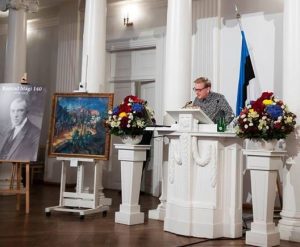Bart Pushaw received a 2018 Dissertation grant to complete archival research for his dissertation in Latvia. He will complete his PhD in Art History at the University of Maryland this spring.
My dissertation “The Global Invention of ‘Art’: Race and Visual Sovereignty in the Colonial Baltic World, 1870-1920” investigates visual art as a realm of multiethnic cooperation and decolonial possibility, revealing how images and the ability to assume the power of image-making were pivotal to changing the strict social stratifications of the Baltic Provinces. Most importantly, I completed archival research about Emīlija Gruzīte, the first Latvian woman to become a professional artist. While I have accessed many primary source documents about her in Latvian newspapers through the portal Periodika, there nevertheless existed a veritable treasure trove of non-digitzied material which I could only access in person in the archives of the Art Academy and other files at the National Library. These sources, including her autobiography and miscellaneous photographs (of pivotal importance of course for scholars of visual culture!), played a key role in helping me complete my last chapter of my dissertation.
 I was able to use this research and channel it into a conference talk which I delivered at an international conference I organized at Kumu Art Museum in Tallinn in January 2019, titled “Symbolist Art and the Baltic Sea Region, 1880-1930.” This conference was in collaboration with the groundbreaking show “Wild Souls: Symbolism in the Art of the Baltic States.” Thus my AABS Summer Research Grant provided critical time to gather the necessary details both to enrich my dissertation, present direct results to both Baltic and international colleagues, as well as begin the path towards exciting new research projects and collaborations I could have never imagined.
I was able to use this research and channel it into a conference talk which I delivered at an international conference I organized at Kumu Art Museum in Tallinn in January 2019, titled “Symbolist Art and the Baltic Sea Region, 1880-1930.” This conference was in collaboration with the groundbreaking show “Wild Souls: Symbolism in the Art of the Baltic States.” Thus my AABS Summer Research Grant provided critical time to gather the necessary details both to enrich my dissertation, present direct results to both Baltic and international colleagues, as well as begin the path towards exciting new research projects and collaborations I could have never imagined.
The second half of my research time spent in Latvia took an unexpected, but exciting turn. My investigation of the collections of the Latvian National Museum of Art led me to an artist whom I was ashamed to not know—Hilda Vīka. Vīka sparked my interest because of the intense nationalist ethos that pervaded many of her works, especially her self-portraits. As the first woman to marry in a dievturi ceremony (to the writer and critic Viktors Eglītis), she wholeheartedly embraced the Ulmanis ultranationalist turn of interwar Latvia. Learning about these dimensions would actually prove pivotal in an unexpected way. I was able to meet with colleagues affilitated with the Latvian Center for Contemporary Art, Inga Lāce and Andra Silapētere, who were looking to expand their publication related to the exhibition “Portable Landscapes: Latvian Exile and Emigre Artists.” I suggested to write about Hilda Vīka, not because she was an exiled artist, but because she stayed specifically because she could not part with her works, and subsequently adapted her watercolors to fit the demands imposed by Stalinist Socialist Realism. I am now preparing such an essay on Vīka and ideas of “home” in late Ulmanis-era Latvia, probing some uncomfortable but necessary questions about the relationship between art, nationalism, and gender across both time and space. This secondary project would have been absolutely impossible had I not had the AABS grant to be in Latvia this summer, and had the opportunity to see Lāce and Silapētere’s exhibition and engage with them so thoroughly. I am especially excited to work on this project because the exhibition will now come to the United States, as it has found a venue in New York, and will open there in fall 2019.
